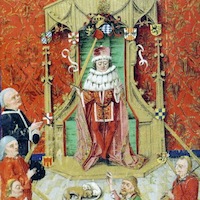 Cet atelier a pour objectif de proposer une première vue d’ensemble de ces programmes héraldiques des salles d’apparat au cours du Moyen âge et de l’Époque moderne en Europe et d’en proposer une première typologie. Dans ce but, nous voudrions intégrer à notre étude des salles d’apparat d’une grande diversité sociale et institutionnelle. Sous salles d’apparat nous entendons, dans ce contexte, des salles qui étaient utilisées pour des cérémonies et qui servaient surtout comme espace identitaire privilégié où étaient accueillis aussi bien les membres de la propre communauté, que ceux qui venaient de l’extérieur.
Cet atelier a pour objectif de proposer une première vue d’ensemble de ces programmes héraldiques des salles d’apparat au cours du Moyen âge et de l’Époque moderne en Europe et d’en proposer une première typologie. Dans ce but, nous voudrions intégrer à notre étude des salles d’apparat d’une grande diversité sociale et institutionnelle. Sous salles d’apparat nous entendons, dans ce contexte, des salles qui étaient utilisées pour des cérémonies et qui servaient surtout comme espace identitaire privilégié où étaient accueillis aussi bien les membres de la propre communauté, que ceux qui venaient de l’extérieur.
Exécutés sur différents supports — peinture, vitrail, faïence, sculpture, tapisserie et tentures, mobilier, et parfois même décors éphémères — ces programmes héraldiques présentaient divers sujets. Ils pouvaient proposer des lectures généalogiques, chevaleresques, légendaires, historiques, littéraires ou commémoratives et refléter des réseaux ou des idéaux politiques et imaginaires. Nous aimerions étudier ces derniers sans les attribuer trop rapidement à un certain milieu social ou type d’institutions.
Pour ces journées d’études, nous voudrions réunir un ensemble de contributions qui puisse fournir une vision large qui atteigne le plus grand nombre possible de typologies aussi bien selon le type de salles d’apparat que selon leurs programmes et leurs supports matériels. En ce faisant, bien au-delà de la simple identification des armoiries présentes, notre questionnement mise surtout à replacer l’ensemble de la représentation héraldique dans son contexte social et institutionnel. Nous cherchons à mettre en lumière la signification de ces programmes héraldiques et leur rôle dans le programme visuel et dans les fonctions de ces salles d’apparat.
Les communications pourront être présentées en anglais ou français. Les réponses sont attendues avant le 15 décembre 2015 avec un court résumé du propos (200 mots) en anglais ou français à l’adresse suivante: heraldica@uni-muenster.de.
Les rencontres sont co-organisées par Miguel Metelo de Seixas (Lisbonne) et Torsten Hiltmann (Münster) dans le cadre du projet de recherche lusitano-allemand In the service of the Crown: The use of heraldry in royal political communication in late medieval Portugal, financé par la Fondation Volkswagen.
http://heraldica.hypotheses.org/3727
***
Heraldry in Medieval and Early Modern State-Rooms: Towards a Typology of Heraldic Programmes in Spaces of Self-Representation
Münster, Germany, 16-18 March 2016
Heraldry was an ubiquitous element of state-rooms. Whether in palaces of kings and princes, castles of noblemen, residences of patricians, city halls or in cathedral chapters, heraldic display was a crucial element in the visual programme of these spaces. Despite its omnipresence, however, heraldic display in state-rooms remains largely understudied so far.
Given the fundamental role of heraldry in medieval and early modern visual communication, it seems essential to incorporate the study of heraldry into our understanding of the state-rooms and their functions. The heraldic programmes appear to have been intimately tied to the functions of those rooms and the strategies of self-representation and communication employed by commissioners and users of such places.
This workshop aims to explore these heraldic programmes in state-rooms in medieval and early modern Europe and to suggest an initial typology of this phenomenon. We would like to include case studies showcasing different social and institutional examples. In the context of the workshop, we understand state-rooms to be rooms used for ceremonies and receptions, and spaces able to construct and express identity that were meant to be witnessed by members of a community itself as well as by outsiders.
We particularly welcome comparative papers on the heraldic display of state-rooms and groups of state-rooms from different geographical, social and institutional contexts. Rather than only identifying the displayed coats of arms, contributions should address the heraldic ensembles in their entirety and locate them in their specific social and institutional contexts, aiming to further our understanding of the functions of heraldic display in the state-rooms and their visual programme.Heraldry in state-rooms was displayed in a variety of media, including, but not limited to, paintings, stained-glass, sculptures, tiles, tapestries, curtains, furniture. As part of ceremonies, it also appeared as ephemeral decor. The topics of such heraldic programmes were diverse. They could represent genealogical, chivalric, legendary as well as historical and commemorative themes, reflect political networks and convey political and imaginary ideas.
Papers can be presented in English or French. Proposals (200 words in French or English) should be sent to heraldica@uni-muenster.de by 15 December 2015.

Leave a Reply
You must be logged in to post a comment.